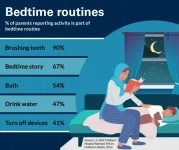(Press-News.org) ANN ARBOR, Mich. – Many bedtime battles stem from children’s after dark worries, suggests a new national poll.
And while most families have bedtime rituals to help their little ones ease into nighttime, many rely on strategies that may increase sleep challenges long term, according to the University of Michigan Health C.S. Mott Children’s Hospital National Poll on Children’s Health.
Overall, one in four parents describe getting their young child to bed as difficult – and these parents are less likely to have a bedtime routine, more likely to leave on a video or TV show, and more likely to stay with their child until they’re asleep.
"Our report reinforces the common struggle of getting young children to sleep. When this transition to bedtime becomes a nightly conflict, some parents may fall into habits that work in the moment but could set them up for more sleep issues down the road,” said Mott Poll co-director Sarah Clark, M.P.H.
“Establishing a consistent bedtime routine is crucial. When children don’t get enough rest, it can impact their physical development, emotional regulation and behavior.”
Nearly one in five parents say they have given their kids melatonin to help with sleep while a third stay in the room until their child completely dozes off, according to the nationally representative poll that includes responses from 781 parents of children ages one to six surveyed in February.
Nighttime worries interfere with sleep
Parents share common reasons behind bedtime struggles, with nearly a quarter saying their child’s sleep is often or occasionally delayed due to being worried or anxious.
A particular challenge, parents say, is when children don’t stay asleep. More than a third of parents say their child wakes up upset or crying, with more than 40% saying their child moves to their parents’ bed and about 30% saying children insist that the parent sleep in their room.
“Many young children go through stages when they become scared of the dark or worry that something bad might happen, causing them to delay bedtime or become distressed by parents leaving the room. Bad dreams or being awakened in the middle of the night can also disrupt sleep,” Clark said.
“Although this is a normal part of a child’s development, it can be frustrating when parents already feel tired themselves at the end of the day. Parents should find a balance between offering reassurance and comfort while maintaining some boundaries that help ensure everyone – both kids and adults – get adequate sleep.”
More findings from the report, plus Clark’s recommendations for helping young children fall and stay asleep:
Stick to a regular bedtime routine
Most parents polled report having a bedtime routine for their child, often including brushing teeth, reading bedtime stories and/or bathing. Less than half also say their child has a drink of water or snack, turns off devices, prays and talks about their day.
Other bedtime habits include holding a blanket or stuff animal or sucking a pacifier or fingers.
Not only does having a consistent bedtime routine help make the nighttime transition smoother, Clark says, it also provides one-on-one time, allowing the child to get their parent’s full attention.
“A predictable bedtime routine provides a sense of security and comfort and signals to the child that it’s time to slow down,” she said.
“Knowing what to expect next can reduce anxiety and help children feel safe and relaxed. Having this dedicated time with parents also promotes bonding and emotional connection, creating positive associations with bedtime.”
Nearly two-thirds of parents also said children staying up to play was a major factor in delaying sleep. Clark says, highlighting the need to wind down at least an hour before bed.
Promote an environment conducive to sleep
A little less than half of parents polled say their child sleeps in their own bedroom while less than a quarter share a bedroom with siblings or in the parents’ bedroom. One in 10 kids spend part the night in their own bedroom and part of the night with parents.
More than two-fifths of parents polled said noise from other rooms interfered with their child’s sleep.
“The sleep environment can have a major effect on a child’s sleep quality, including getting to sleep and staying asleep through the night,” Clark said.
“When possible, children should have their own bed in a room that is quiet, without a lot of noise from other family members.”
Many parents polled also use a nightlight or crack the bedroom door so the child isn’t in complete darkness, Clark says, but parents should make sure the light does not shine directly at the child’s face.
Some parents also play calming music or stories to help their child go to sleep, while others use a white noise machine or app. However, Clark cautions to keep white noise machines at no more than 50 decibels and placed at least seven feet from the child’s bed to prevent unintended damage to the child’s hearing.
Talk to a doctor before using aids like melatonin
Many types of melatonin products are advertised as being appropriate for children but these products have not undergone rigorous testing for safety and effectiveness, and their side effects and long term impact on a child’s growth and development are unknown, Clark says.
“Although melatonin is a natural hormone that regulates sleep-wake cycles and may be fine to use occasionally, parents shouldn’t rely on it as a primary sleep aid,” Clark said.
“Parents who are considering giving melatonin to their young child should consult with their pediatrician to discuss options and rule out other causes of sleep problems first.”
If using melatonin, parents should also start with the lowest dose possible.
In addition, it's important to keep electronics such as tablets or televisions out of children’s bedroom, as the blue light emitted by many of these screens interferes with the natural production of melatonin.
Offer comfort but enforce boundaries
Parents can help ease little ones’ anxiety by allowing extra time to let them talk about their day, which might draw out specific worries and give parents a chance to provide compassion and reassurance, Clark said.
Rather than remaining in the room, parents can also offer to check on the child every few minutes, which acknowledges the child’s fears and offers a reassuring presence, but still maintains a calm sleep environment and promotes sleep independence.
“Families can incorporate comforting rituals to help transform nighttime fears into a calming experience,” Clark said.
Have a consistent approach when children wake up in the night
Some children are prone to vivid dreams or nightmares and may have difficulty getting back to sleep. Parents should decide on their approach to this situation and stick with it, Clark says, whether it’s taking the child back to bed or allowing them to stay in the parents’ room.
“Being consistent in carrying out that approach will help the child adjust and be more likely to return to sleep,” Clark said.
Ease into changes in sleep patterns, such as dropping naps
For young children, a major sleep-related transition is discontinuing daytime naps. In general, children ages one to two should get 11-14 hours of sleep with naps while the amount of recommended sleep decreases slightly from ages three to six.
If children are taking longer to fall asleep at nap time, resisting naps or suddenly having difficulty falling asleep at night or waking up earlier than usual in the morning, it may be time to drop the nap, Clark says.
“Parents may need to adjust sleep routines gradually to transition to changes to a child’s sleep patterns,” Clark said.
Other changes that can affect a child’s sleep include transitioning from a crib to a toddler bed, starting school, having a change in their daytime routine, or being outdoors for longer than usual.
END
Bedtime battles: 1 in 4 parents say their child can’t go to sleep because they’re worried or anxious
1 in 5 parents give young children melatonin to help with bedtime while 1 in 3 stay in the room until their child falls asleep, poll suggests
2024-06-17
ELSE PRESS RELEASES FROM THIS DATE:
Towards wider 5G network coverage: novel wirelessly powered relay transceiver
2024-06-17
A novel 256-element wirelessly powered transceiver array for non-line-of-sight 5G communication, featuring efficient wireless power transmission and high-power conversion efficiency, has been designed by scientists at Tokyo Tech. The innovative design can enhance the 5G network coverage even to places with link blockage, improving flexibility and coverage area, and potentially making high-speed, low-latency communication more accessible.
Millimeter wave 5G communication, which uses extremely high-frequency radio signals (24 to 100 GHz), is a promising technology for next-generation wireless ...
Nile perch invasion triggered genetic bottlenecks in lake Victoria's endemic cichlids
2024-06-17
Newfound evidence reveals that the upsurge of the exotic Nile perch in Lake Victoria had long-lasting effects on the genetic diversity of various local cichlid species, report scientists from Tokyo Tech. Through large-scale comparative genomic analyses, the researchers found concrete proof in the collective genome of multiple species that this artificially introduced perch decimated many local fish populations, causing a 'bottleneck effect.'
The careless introduction of exotic species by humans into ecosystems can lead to truly catastrophic results, as has been ...
Wildfire smoke and health
2024-06-17
With wildfires becoming more frequent and extensive in Canada, it’s important for people to understand the health risks of wildfire smoke. An article in CMAJ (Canadian Medical Association Journal) https://www.cmaj.ca/lookup/doi/10.1503/cmaj.240135 aims to provide information for clinicians and people in Canada as wildfire season is upon us.
"As climate change causes more frequent and severe wildfires, wildfire smoke becomes a larger health problem,” says Dr. Mehdi Aloosh, assistant professor, Health Research Methods, Evidence, and Impact, McMaster University, Hamilton, and medical officer of health of Windsor–Essex County, Ontario. “Communities need ...
US sexual health curriculum could force LGBTQ+ students to seek potentially inaccurate education outside of school
2024-06-17
Children across the United States who identify as LGBTQ+ say the sexual health education curricula they receive is leaving them without essential information to make informed decisions about their sexual health – which could force them to seek potentially dangerous advice elsewhere.
The results of a new, national, peer-reviewed survey, show that these young people — aged 13 to 17 — believe crucial topics surrounding sexual orientation and gender identity are being omitted from sexual health education programs.
Experts who led the study – published today in The Journal of Sex Research, as people around the ...
Increasing use and awareness of oral nicotine pouches detailed
2024-06-17
WASHINGTON – A rigorous, comprehensive synthesis of evidence from 62 studies related to the use of oral nicotine pouches by Georgetown University’s Lombardi Comprehensive Cancer Center scientists and colleagues provides a much-needed assessment of how these products could lead to potential harmful consequences if used by young people.
Oral nicotine pouches were first introduced in the U.S. in the past decade and are pre-portioned white granular packets containing nicotine placed between the gums and lips, marketed as tobacco-free, and are sold in various flavors and nicotine strengths.
The findings appeared ...
Wirelessly powered relay will help bring 5G technology to smart factories
2024-06-17
A recently developed wirelessly powered 5G relay could accelerate the development of smart factories, report scientists from Tokyo Tech. By adopting a lower operating frequency for wireless power transfer, the proposed relay design solves many of the current limitations, including range and efficiency. In turn, this allows for a more versatile and widespread arrangement of sensors and transceivers in industrial settings.
One of the hallmarks of the Information Age is the transformation of industries towards a greater flow of ...
A novel 640 Gbps chipset paves the way for next generation wireless systems
2024-06-17
A new D-band CMOS transceiver chipset with 56 GHz signal-chain bandwidth achieves the highest transmission speed of 640 Gbps for a wireless device realized with integrated circuits, as reported by researchers from Tokyo Tech and National Institute of Information and Communications Technology. The proposed chipset is highly promising for the next generation of wireless systems.
To achieve faster speeds and handle increasing data traffic, wireless systems are operating in higher millimeter-wave frequency bands. Current high-band 5G systems offer speeds as high as 10 Gbps and operate in frequency bands between 24–47 GHz. The next generation ...
How disposable vapes have become a prominent part of young people’s lives
2024-06-17
Peer-reviewed – Qualitative study - Humans
A new study has provided an in-depth look into the rising trend of disposable vape use among young people in the UK.
The research, led by the University of East Anglia, reveals that young people see smoking and vaping as interchangeable, but are far more aware of the potential harms of vaping than they are of the dangers of smoking.
The findings also suggest that banning disposable vape products or increasing their prices could lead young people to revert to smoking tobacco.
Many of the young people questioned also believed that ...
Berberine could treat eczema-exacerbated staph infections
2024-06-16
Atlanta, Ga.—Eczema, a skin inflammatory disease that causes dry, itchy and inflamed skin, affects millions worldwide. Eczema is associated with an altered skin microbiome and higher colonization by Staphylococcus aureus. The study, led at New York Medical by postdoctoral fellow Anish R. Maskey, Ph.D., focuses on the natural compound berberine and its impact on eczema exacerbated by S. aureus. The findings, presented at ASM Microbe, shed light on berberine’s ability to inhibit S. aureus colonization and alleviate eczema symptoms without adverse effects.
Current ...
NIH-funded intervention did not impact opioid-related overdose death rates over evaluation period
2024-06-16
A data-driven intervention that engaged communities to rapidly deploy evidence-based practices to reduce opioid-related overdose deaths – such as increasing naloxone distribution and enhancing access to medication for opioid use disorder – did not result in a statistically significant reduction in opioid-related overdose death rates during the evaluation period, according to results from the National Institutes of Health’s HEALing (Helping to End Addiction Long-Term) Communities Study. Researchers identified the COVID-19 pandemic and increased prevalence ...
LAST 30 PRESS RELEASES:
Revealing the diversity of olfactory receptors in hagfish and its implications for early vertebrate evolution
Development of an ultrasonic sensor capable of cuffless, non-invasive blood pressure measurement
Longer treatment with medications for opioid use disorder is associated with greater probability of survival
Strategy over morality can help conservation campaigns reduce ivory demand, research shows
Rising temperatures reshape microbial carbon cycling during animal carcass decomposition in water
Achieving ultra-low-power explosive jumps via locust bio-hybrid muscle actuators
Plant-derived phenolic acids revive the power of tetracycline against drug-resistant bacteria
Cooperation: A costly affair in bacterial social behaviour?
Viruses in wastewater: Silent drivers of pollution removal and antibiotic resistance
Sub-iethal water disinfection may accelerate the spread of antibiotic resistance
Three in four new Australian moms struggle with body image
Post-stroke injection protects the brain in preclinical study
Cardiovascular risk score predicts multiple eye diseases
Health: estimated one in ten British adults used or interested in GLP-1 medications for weight loss
Exercise to treat depression yields similar results to therapy
Whooping cough vaccination for pregnant women strengthens babies’ immune system
Dramatic decline in new cases of orphanhood in Uganda driven by HIV treatment and prevention programs
Stopping weight loss drugs linked to weight regain and reversal of heart health markers
Higher intake of food preservatives linked to increased cancer risk
Mass General Brigham–developed cholera vaccine completes phase 1 trial
First experimental validation of a “150-year-old chemical common sense” direct visualization of the molecular structural changes in the ultrafast anthracene [4+4] photocycloaddition reaction
Lack of support for people on weight loss drugs leaves them vulnerable to nutritional deficiencies, say experts
Dogs’ dinners can have greater climate impact than owners’
Are you ready to swap salmon for sprats and sardines?
1.6 million UK adults used weight loss drugs in past year
American College of Cardiology comments on new dietary guidelines for Americans
American Society of Gene & Cell Therapy and Orphan Therapeutics Accelerator partner to advance and commercialize promising rare disease treatments
One in 14 patients having day case surgery have new or worse chronic pain 3 months after their operation
New study highlights link between eviction rates and gun violence
Heatwaves heat up soil but not toxin levels in rice, study finds
[Press-News.org] Bedtime battles: 1 in 4 parents say their child can’t go to sleep because they’re worried or anxious1 in 5 parents give young children melatonin to help with bedtime while 1 in 3 stay in the room until their child falls asleep, poll suggests





